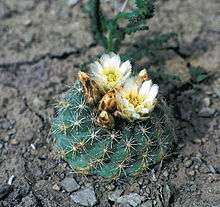Sclerocactus mesae-verde
Sclerocactus mesae-verde, Mesa Verde cactus or Mesa Verde fishhook cactus, is a species of cactus in the Sclerocactus genus occurring in habitat at 4000–5000 ft. only in Colorado and New Mexico in the Four Corners region, United States.[1][2] This species was discovered near Cortez and Mesa Verde by Charles H. Boissevain, and is the only known population group in Colorado. Sclerocactus mesae-verde was formerly classified in the monotypic genus Coloradoa.[3]
| Sclerocactus mesae-verde | |
|---|---|
 | |
| Scientific classification | |
| Kingdom: | |
| (unranked): | |
| (unranked): | |
| (unranked): | Core eudicots |
| Order: | |
| Family: | |
| Subfamily: | |
| Tribe: | |
| Genus: | |
| Species: | S. mesae-verde |
| Binomial name | |
| Sclerocactus mesae-verde | |
| Synonyms | |
|
Coloradoa mesae-verde Boissev. | |
Distribution
Along with the one Colorado population (1,000 plants), in New Mexico the Sclerocactus mesae-verde population groups (4,000–10,000 plants) are in a four desert locations.[4] These five major population groups have been registered as threatened, and there are up to a total of 10 population groups left in the wild. Since 1997 federally and 2003 globally Sclerocactus mesae-verde has been an officially listed threatened species.[3] It is most frequently found growing on the tops of hills or benches and slopes of hills, from gravelly to loamy and pulverulent clay soil.[1]
Description
The species is globulous and singular, but sometimes form clusters up to 15. The plant is very small, with a maximum size of only 2 to 2.5 inches in height, 3 to 3.5 inches in diameter.[1] There are up to 14 spiral-like ribs. The flowers are white to cream-yellow, 3 cm long, 2 cm in diameter and do not open completely. The fruits are green, spherical, with a diameter of 1.25 cm. The fruits become brown with age, and split horizontally. The seeds are black.[3]
Conservation and poaching
As with many slowly maturing desert cacti, the Mesa Verde Cactus has been subjected to over-harvesting and "poaching," contributing to its decline in the wild. Among the cacti, it is particularly sensitive to the effects of illegal cactus collecting due to its small population size, limited range, and low reproductive success rate.[3]
The Sclerocactus mesae-verde cactus is intolerant to transplantation, wild-collected specimens usually die in cultivation, making the "poaching" pointless and eliminating potentially important genetic variation from the species as a whole.[3]
| Wikimedia Commons has media related to Sclerocactus mesae-verdae. |
References
- Spackman, S.; Jennings, B.; Coles, J.; Dawson, C.; Minton, M.; Kratz, A.; Spurrier, C.; Skadelandl, T. 1997. Colorado Rare Plant Field Guide. Fort Collins, CO: Prepared for the Bureau of Land Management, the U.S. Forest Service, and the U.S. Fish & Wildlife Service by the Colorado Natural Heritage Program. . accessed 9/19/2010
- Benson, L. 1982. The Cacti of the United States and Canada. Stanford, California: Stanford University Press. 1044p.
- "Sclerocactus mesae-verdae". CPC National Collection Plant Profiles. Center for Plant Conservation. Retrieved 25 June 2017.
- Tepedino, V.J. 2002. Section III. Environmental Monitoring. III.5 The Reproductive Biology of Rare Rangeland Plants and Their Vulnerability to Insecticides. Grasshoppers: Their biology, identification and management, User Handbook.
